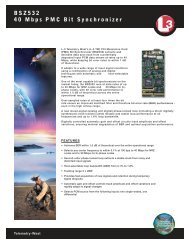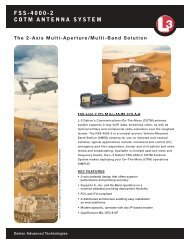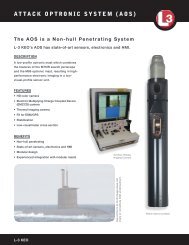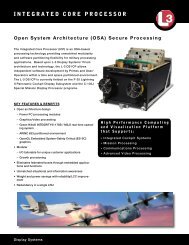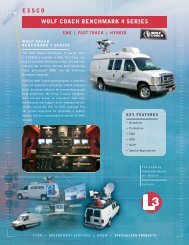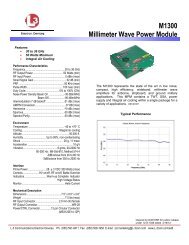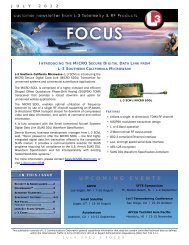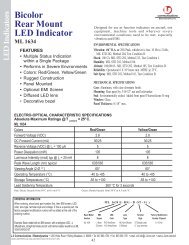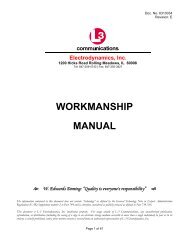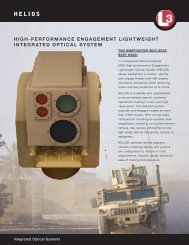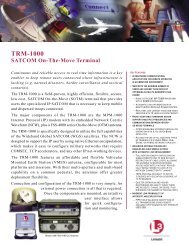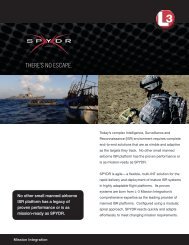Copyright © 2009 IEEE. Reprinted from Microwave Magazine - L-3 ...
Copyright © 2009 IEEE. Reprinted from Microwave Magazine - L-3 ...
Copyright © 2009 IEEE. Reprinted from Microwave Magazine - L-3 ...
You also want an ePaper? Increase the reach of your titles
YUMPU automatically turns print PDFs into web optimized ePapers that Google loves.
Electronics. HiFIVE is developing amplifiers at 220 GHz,and Terahertz Electronics is developing them at 670,850, and 1030 GHz. They both include vacuum electronicstechnologies. The emer ging requirements willcontinue to push the vacuum electronics field to newlevels of performance through advances in areas suchas new physics-based advanced modeling and simulationtools, innovative cathodes, and new fabricationtechniques. Spatially distributed electron beams suchas multiple beams and sheet-beam topologies supportedby microfabrication and refinements in materials,magnetics, and electron sources, will contributeto growth opportunities. Advances in power supplytechnology may well be an important next step in sizereduction. Examples of these research efforts are givenin the following sections.Cold Cathodes for VacuumElectronics AmplifiersThe cathode lies at the heart of every vacuum electronicsRF amplifier, powering the energy-exchange circuitryfor conversion of electron kinetic energy to energy of apropagating electromagnetic wave. The cathode’s solepurpose is to create a high- energy electron beam thatstreams through the vacuum in relative proximity to thedevice’s RF circuit. Current technology employs almostexclusively thermionic cathodes—i.e., metallic compositesthat are heated by various means to near 1,000 °C. Atsuch temperatures, electrons that are normally bound tothe cathode’s metallic lattice can be extracted <strong>from</strong> thecathode surface if their thermal energies exceed the cathode’ssurface vacuum potential barrier. This method ofcreating free-streaming electron beams in a vacuum hasbeen successively employed for more than 60 years.Quantum mechanics, however, holds the promiseof fundamentally altering the method used to createstreaming electron beams in vacuums—one that willenable revolutionary performance gains for the devicesthat employ it. These cold cathodes do not requirehigh thermal electron energies for beam emission, butinstead rely on quantum mechanical tunneling thoughthe vacuum potential barrier, a barrier distorted by thecreation of high cathode surface electric fields. Figure 11depicts the potential energy diagram for electrons at thesurfaces of a thermionic cathode and a cold cathode,both at room temperature. In the case of the thermioniccathode, without additional energy q e Dw, the electronsare bound to the cathode surface and cannot escape intothe vacuum. The additional energy required must come<strong>from</strong> direct heating of the cathode via external means.In the case of the cold cathode, no additional thermalenergy is available. Instead, the shape of thevacuum barrier is distorted via application of a highelectric field to the cathode surface. The barrier isnot reduced to zero, however, and the cathode relieson quantum mechanical tunneling through the barrier,which allows for transit of electrons throughMultiple-beam klystrons offerthe advantages of reduced beamvoltage, reduced size and weight,and increased bandwidth.the forbidden zone with a nonzero probability. If thesurface electric field and vacuum barrier distortionbecome high enough, then the tunneling probabilityincreases to levels that allow sufficient vacuum currentto be extracted.To create the necessary high cathode surfacefields, new methods of cathode fabrication havebeen developed that replace the metal composites ofthe thermionic cathode with a microfabricated siliconsubstrate upon which are formed several electricfield-enhancing features. Figure 12 comparesthe surface geometry and electric field values of(a) a thermionic cathode, (b) a microfabricated coldcathode substructure with field-enhancing dielectriclayer, and (c) a microfabricated cold cathode witha field-enhancing dielectric layer and an additionalfield-enhancing cone emitter. The dielectric layerincreases the electric field over that of a thermioniccathode by about 100 times, and the cone emittersadd an additional factor of 10–100 times at the apexof the cone, creating electric fields that ultimatelyexceed the threshold for room temperature electronemission into the vacuum.The cone emitters of Figure 12(c) have micronsizedfeatures, and, typically, each produce 1–10 mAof vacuum current. The small feature size and use ofmicrofabrication techniques allow for large arraysof such emitters 110 4 210 5 2 to be manufactured ontoPotential EnergyΔφ0CathodeConductionBandΔφ0Thermionic CathodeElectronWave FunctionVacuumZero Beam EmissionWithout ExternalHeatingCold CathodeVacuumCathodeElectronConductionTunneling andBandBeam Creation25 °CDistanceFigure 11. Energy diagram for a thermionic cathode anda cold cathode. The high surface electric field for the coldcathode distorts the potential barrier and allows tunneling.December <strong>2009</strong> 45Authorized licensed use limited to: US Army Research Laboratory. Downloaded on December 2, <strong>2009</strong> at 13:24 <strong>from</strong> <strong>IEEE</strong> Xplore. Restrictions apply.



